This chapter describes how satisfied Nova Scotians were with their personal health, as well as the degree to which their activity was limited by a health problem or injury. Estimates of the level of caregiving excluding paid or volunteer work are presented, along with an estimate of individuals at risk for depression.
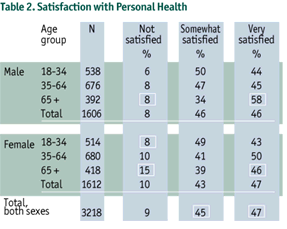
How individuals feel about their own health is usually a reflection of their physical, mental and social well-being. The rating may also reflect aspects of health- related behaviours and personal characteristics such as education or socioeconomic level (Krause&Jay, 1994; Smith, Shelley & Dennerstein, 1994). Self-rated health has been found to correlate well with symptoms and actual health measures as well as use of health services. It is also a good independent predictor of longevity (Fylkesnes & Forde, 1992).
When asked how satisfied they were with their own health, 92% of Nova Scotians reported being somewhat or very satisfied (Table 2). Older women (65+ years) were less likely to be satisfied with their health than older men and young women (18-34 years) (p < 0.05). Older men were more likely than any other age and sex group to be very satisfied with their health.
Seventeen percent of Nova Scotians reported that because of a long-term health problem they were limited in the kind or amount of activity they could do, compared to people of the same age. The percentage of people reporting limitations increased with age and was similar for men and women, except for the 35-64 year age group. In this age group more men (21%) than women (16%) reported health-related limitation of activities (p < 0.05) (Table 3).
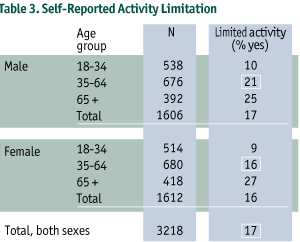
When the health problems that led to activity limitations were considered, musculoskeletal problems were linked to limitation most frequently by 51% of adults, followed by cardiovascular problems (13%), and respiratory problems (10%) (Table 4). The percentage of health limitation resulting from CVD increased with age, while the highest level of respiratory problems occurred in the youngest age group. Thirty percent of those with some degree of health-related activity limitation said injury or accident was the cause, and the percentages were highest in the age groups below 65 years. Injury or accident was more likely to be a reason for health limitation in men than in women.
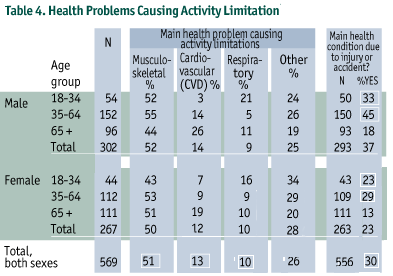
Nova Scotians were also asked about their need for help with personal care activities such as eating, bathing, dressing, or getting around inside the house. Only 2% of respondents reported such a need, and most were aged 65 years and older. Almost twice as many older women (7%) as older men (4%) expressed this need.
Many Nova Scotians provide assistance with activities of daily living or personal care to families and friends. To assess the prevalence of this type of assistance, respondents were asked whether they provided any kind of help or care for a person with a chronic illness or disabling condition lasting or expected to last 30 days or more. Responses were not to include volunteer or paid work.
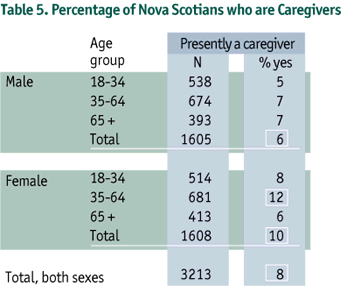
Eight percent of Nova Scotians (10% of females and 6% of males) reported being caregivers. Women age 35-64 years were most frequently identified as providing this assistance (12%) (Table 5).
Female caregivers helped most with personal care activities such as washing, grooming, and bathing, as well as domestic chores such as laundry, grocery shopping, meal preparation, and light housework. Males helped more often with transportation, home maintenance, snow shovelling, and money management (Table 6).
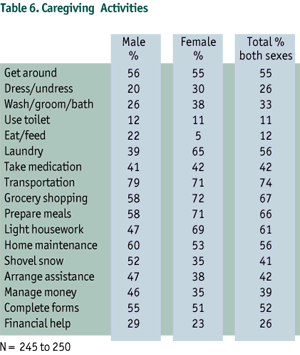
Almost half of adult caregivers (45%) indicated that this role was rarely or never stressful for them. Fifty-five percent reported at least some stress, and within this group, 15% were often or always stressed (Table 7). However, on further questioning, the majority of caregivers (83%) indicated that they were usually or always able to cope.
Health includes much more than physical well-being. There are well-known psychological and social conditions that affect health just as physical disease does. Of particular concern in today's world are the issues of stress, anxiety, and depression and how these affect health. Psychological variables such as depression, anxiety, hostility, stress, and social support have been associated with increased levels of heart disease in several American and European studies (Booth- Kewley&Friedman, 1987; Matthews, 1988; Matthews, 1989; Ragland&Brand, 1988). Unfortunately, very little is known about the association of these variables with CVD for Canadian samples. The NSHS95 included standardized questions about these variables in an effort to provide some insight into the prevalence of the psychological factors associated with heart disease and the mental well-being of adult Nova Scotians. Only the results concerning the prevalence of depressive symptoms and emotional distress are reported here. The findings from the stress, hostility, anxiety, and social support measures will be available at a later date.
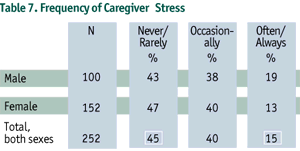
Depression rates are useful indicators of the mental health of a population and may be measured in two ways: as a disorder in which someone is either clinically depressed or not; or as a range, where depressive symptoms may run from a few to many (Anastasi, 1982). The NSHS95 measured a range of depressive symptoms and emotional distress using the Centre for Epidemiologic Studies Depression (CES-D) Scale [9]. (Devins&Orme, 1984; Radloff, 1977). This measure included symptoms associated with depression, including low, sub-clinical levels such as feeling blue or down, having difficulties or significant changes in sleeping and eating patterns, and feeling substantially less motivated or less hopeful about the future. The CES-D scale is appropriate for use in epidemiological surveys of depression within the general population. Respondents answered 20 questions assessing the frequency or duration of symptoms associated with depression in the preceding week. A score of 0-60 was possible, with higher scores representing greater degrees of depressed mood. A score of 16 or greater classifies a person as being at risk for depression. Table 8 shows the findings of the CES-D scale based on scores equal to or greater than 16. Depressive symptoms were common among younger women age 18-34. These women had the highest rate of depressive symptoms (22%), while men in the oldest age group had the lowest rate (8%). Moreover, almost twice as many women as men aged 65 and over had elevated scores. Overall, one in seven adults and slightly more than one in five young women (18-34) was at risk for depression.
2CES-D>16:Classifies a person as being at risk for depression.
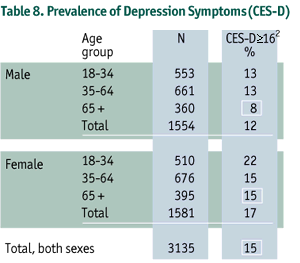
This chapter described how individual adult Nova Scotians rated their health, and presented data on the percentage of people who experienced activity limitations due to health problems, acted as caregivers, or showed signs of depression symptoms. This information was assembled to illustrate how Nova Scotians feel about their health and to describe features of the population that concern health care providers and consumers in a time of changing needs.
Most Nova Scotians were either satisfied or very satisfied with their health. This result is not uncommon when people are asked to rate their health in general, yet it does not necessarily indicate that people are at an optimum level of health. Older men (65+ years) reported being very satisfied with their health more often than older women and other age/sex groups. A greater proportion of older women were not satisfied with their health. While this signals a difference between older men and women based on sex, the difference is more likely due to age. Women tend to live longer and therefore may be more likely to experience discomforts associated with aging. Further analysis may help to explain this result.
Seventeen percent of the population indicated activity limitations due to health problems, and this increased with age. Limitations were most often linked to musculoskeletal problems (51%), and cardiovascular and respiratory problems were also contributors.
Given that nearly one-fifth of the population were experiencing activity limitations and that this number may increase as the population ages, it was important to know the number of Nova Scotians who were currently helping others with activities of daily living. Eight percent of the population were acting as caregivers, and the majority were women. While many caregivers expressed feeling stress, 83% stated that they were coping with their caregiving responsibilities.
Further assessment of individual well-being was examined with responses to statements designed to measure symptoms of depression. Those at risk for depression (CES-D > 16), represented 15% of the population; and these results were most common in young women age 18-34 (22%). Older men were least likely to show symptoms of depression.